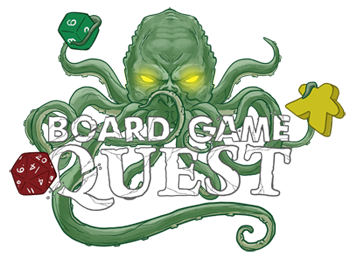 Goblin pirate ships with unicorn figureheads. Epic seaborn showdowns between Ninjas and mercenaries. Sea monsters, big and small. All of this and more are jam packed into the Sea King Adventure Card Game by Party Pug Games.
Goblin pirate ships with unicorn figureheads. Epic seaborn showdowns between Ninjas and mercenaries. Sea monsters, big and small. All of this and more are jam packed into the Sea King Adventure Card Game by Party Pug Games.
Is it possible for this riot of styles and themes to all work together harmoniously, creating an interesting and exciting game system? Or is it just too much all at once, jumbling together into a confusing meld?
Gameplay Overview:
Every player is assigned a captain card, all with their own abilities. The different draw decks—including fortunes, supplies, and adventures—are laid out on deck marker boards in the center of the playfield. Everyone gets a player board and markers to track their combat rating, HP, and trophies. The game ends when one player achieves a set number of trophies.
On their turn, players draw supply cards that can give them boosted abilities, including ship parts. If you collect ship parts that match, like the Jade Dragon ship theme, the bonuses stack, giving you the best opportunity to increase your defense score. Once you’ve selected which cards to play into your tableau, you draw an adventure card with a monster to battle. Using the defense value you’ve accumulated through your ship and bonus cards, as well as curse or boon cards that may play in your favor, you try to best the monster’s combat rating. If you succeed, you collect a reward, including extra draw cards and trophy points. If you lose, your HP goes down.

Game Experience:
When I opened up the game and started looking at the cards, one of the first things I did was flip to the back of the Rulebook to see the artists credited. I didn’t see any clear mention of AI, so I contacted the publisher. Niles at Party Pug Games was helpful and open about the fact that they did use Midjourney (the same AI generation tool used by Stronghold Games for the More Terraforming Mars expansion) as part of the art creation process, in conjunction with Adobe Photoshop, which includes AI assisted tools. The ethics and copyright issues of AI use in the creative arts are a hot button topic right now, so I’ll leave interested gamers to make their own judgments. (Editor’s Note: Beyond current commitments, Board Game Quest is not planning on covering games in the future that use AI art).

What I will say is that there is a lot of art. There are more than 200 unique full color cards, representing a scattershot of art styles and themes. From faux Ninja Turtles to Alice in Wonderland-esque characters, there are a wide variety of options, and probably something for every taste. This doesn’t necessarily read as cohesive, but it does add to the general tone of zany chaos that the game is going for. The real highlight of the art are the ships. Drawing the right cards to piece together a beautifully detailed pirate ship is satisfying. Upgrading components to increase your defense score feels worthwhile, and the fully assembled ships are the most impressive part of the game. Complete they also earn you the advantage of getting a first mate card, which rewards the effort.
We had a few points of confusion while playing, though. For example, there are helm, hull, and figurehead equipment cards, but also helm and figurehead ability cards. They look almost identical, except for the small modifier word, and in our first game we played them incorrectly. Some of the captains felt much more powerful than others, and some ability cards felt unbalanced at the beginning of the game. The curses and boons often junked up our hands with cards we just weren’t interested in playing.

There are also a few copyediting and formatting issues with the rulebook, although these didn’t impact our gameplay. It bothered us that the monster card text was vertically aligned, despite most (but confusingly not all) of the art being horizontally aligned. The art style of the monsters is supposed to be differentiated based on monster difficulty, but when you’re only fighting one monster at a time it all blurs together.
I will say that Sea King Adventures is fairly easy to learn, and there are helpful turn descriptors on the player mats that make it easy to teach. Once we got the hang of it, we felt like gameplay seemed really familiar. Later we realized that it’s because this game runs very similarly to Munchkin, with a couple of extra frills added on.
Final Thoughts:
I really wanted to like this game more. The concept of a pirate sea battle card game with a Smash Up style cacophony of characters is fun in ideation. On the whole, though, despite how varied the art inspirations are, it all just feels a bit muddy. The cards blend into one another without much definition and identity, and there’s no incentive to build thematically beyond matching your ship cards. If you’re not a fan of the take-that, curse pile-on that happens in the back half of a game of Munchkin, you probably won’t enjoy the end game of Sea King Adventure, either.
Final Score: 2 Stars – This game hasn’t reinvented the wheel or presented anything particularly innovative, and there are other games in this category that have delivered similar products that are higher quality and more fun to play.
 Hits:
Hits:
• Puzzling together the ship pieces is rewarding
• There art is plentiful
Misses:
• At the $69.99 price point, there are other games that deliver a similar experience for much less
• The art has a very single note, undynamic visual feel
• Gameplay is repetitive and drawn out






















